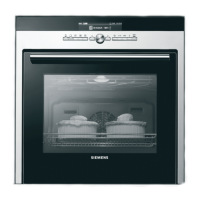9
completely enamelled. As a result, these edges can be
rough. This will not impair the anti-corrosion protection.
■ Unpleasant odours, e.g. after fish has been prepared, can be
removed very easily. Add a few drops of lemon juice to a cup
of water. Place a spoon into the container as well, to prevent
delayed boiling. Heat the water for 1 to 2 minutes at
maximum microwave power.
Cleaning agents
To ensure that the different surfaces are not damaged by using
the wrong cleaning agent, observe the information in the table.
Do not use:
■ any caustic or abrasive cleaning agents,
■ metal or glass scrapers to clean the glass in the appliance
door,
■ metal or glass scrapers to clean the door seal,
■ hard scouring pads and sponges,
■ cleaning agents with high concentrations of alcohol.
Rinse out new sponge cloths thoroughly before use.
For easier cleaning, you can switch on the oven light. Open the
appliance door to do so.
Malfunction table
Malfunctions often have simple explanations. Please refer to the
malfunction table before calling the after-sales service.
If a meal does not turn out exactly as you wanted, refer to the
Tested for you in our cooking studio section, where you will
find plenty of cooking tips and tricks.
: Risk of electric shock!
Incorrect repairs are dangerous. Repairs may only be carried
out by one of our trained after-sales engineers.
Malfunction table
Area Cleaning agents
Appliance front Hot soapy water:
Clean using a dish cloth and then dry with
a soft cloth. Do not use glass cleaners or
metal or glass scrapers for cleaning.
Door panels Glass cleaner:
Clean with a dish cloth. Do not use a glass
scraper.
Glass cover for the
cooking compart-
ment light
Hot soapy water:
Clean with a dish cloth.
Door seal
Do not remove.
Hot soapy water:
Clean with a dish cloth; do not scrub. Do
not use a metal or glass scraper for clean-
ing.
Stainless steel Hot soapy water:
Clean using a dish cloth and then dry with
a soft cloth. Remove traces of limescale,
grease, starch and albumin (e.g. egg
white) immediately. Corrosion can form
under such residues. Special stainless
steel cleaning agents can be obtained
from the after-sales service or from spe-
cialist retailers.
Accessories Hot soapy water:
Soak and clean with a dish cloth or a
brush.
Cooking compart-
ment made of
stainless steel
Hot soapy water or a vinegar solution:
Clean using a dish cloth and then dry with
a soft cloth.
If the oven is very dirty: use oven cleaner,
but only when cooking compartment is
cold. It is best to use a stainless-steel
sponge. Do not use oven spray or other
aggressive oven cleaners or abrasive
materials. Scouring pads, rough sponges
and pan cleaners are also unsuitable.
These agents scratch the surface. Allow
the interior surfaces to dry thoroughly.
Area Cleaning agents
Problem Possible cause Remedy/information
The appliance does not work Faulty circuit breaker Look in the fuse box to make sure that the
fuse for the appliance is OK.
Plug not plugged in Plug in the plug
Power cut Check whether the kitchen light is working.
Incorrect operation Switch off the circuit breaker in the fuse box.
Reconnect the circuit breaker after approx.
10 seconds.
The appliance is not in operation. A
cooking time appears in the display.
The start button was not pressed after the set-
ting had been made.
Press the start button or switch off the appli-
ance.
The microwave does not switch on. The door was not fully closed. Check whether food remains or foreign
material is trapped in the door. Make sure
that the sealing surfaces are clean. Check
whether the door seal is twisted.
The start button was not pressed. Press the start button.

